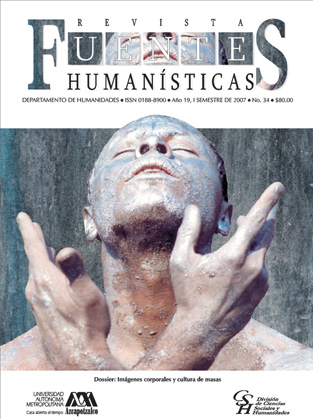Pornografía hipertélica: cuerpo y obscenidad en el arte contemporáneo
Abstract
Pareciera que en la actualidad la obscenidad no demarca el espacio del arte convirtiéndose en su límite, su marco o su margen, sino que, en cambio, entra en escena y transforma radicalmente el propio espacio de la representación. La pornografía convertida en arte o el arte convertido en pornografía, este fenómeno transestético parece conducirnos a una suerte de pornografía hipertélica, la pornografía se excede a sí misma, transgrede sus propios límites y entra en el espacio artístico revirtiendo las reglas del juego de la representación. En este sentido, la obscenidad es, más que nada, un régimen de visibilidad exacerbada, de promiscuidad de la mirada, la desaparición de la distancia escénica en la inmediatez de unos cuerpos arrojados a la voracidad escópica.Downloads
References
BIBLIOGRAFÍA
Andrade, Roberto (2001) “Los 15 performance
más guarros de la historia”, en
Generación, Año XIV, Tercera Época,
núm. 45.
Barthes, Roland (1978) Roland Barthes por
Roland Bartes, Barcelona, Kairós.
(1987) El susurro del lenguaje,
Barcelona, Paidós.
(1995) El placer del texto, México,
Siglo Veintiuno Editores.
(1987) La cámara lúcida, Barcelona,
Paidós.
(2001) La torre Eiffel, Barcelona,
Paidós.
Bataille, George (1969) Documentos,
Venezuela, Monte Ávila.
Baudrillard, Jean (1993) La transparencia
del mal, Barcelona, Anagrama.
(1998) De la seducción, Madrid,
Cátedra.
(1997) La ilusión y desilusión estéticas,
Venezuela, Monte Ávila editores.
(1996) Las estrategias fatales,
Barcelona, Anagrama.
(1997) La transparencia del mal,
Barcelona, Anagrama.
(1998) El crimen perfecto, Barcelona,
Anagrama.
Bolíver, Rocío (2001) “En cueros me verás”,
en Generación, año XII, 3a. Época,
núm.32.
(2001) “En mi mente”, en Generación,
año XIV, 3a. Época, núm.45.
(2002) Saber escoger, México, El
espectáculo editorial.
Carter, Angela (1981) La mujer sadiana,
Barcelona, Edhasa.
Cody, Gabrielle (ed) (2001) Hardcore from
the Heart: The Pleasures, Profits and
Politics of Sex in Performance /Annie
Sprinkle: SOLO New York, Continuum.
Grosenick, Uta (ed) (2002) Mujeres artistas
de los siglos XX y XXI, Italia, Taschen.
(ed) (2002) Art Now, Italia,
Taschen.
Kauffman, Linda (2000) Malas y perversos,
Madrid, Cátedra.
Kendrik, Walter (1996) The Secret Museum,
California, University of California.
Leonard, Zoe (1993) “Entrevista con Laura
Nottingham”, texto electrónico, disponible
en: http://www.enfocarte.com/
13/entrevista.html
Merrit, Natacha (2000) Digital Diaries,
Germany, Taschen.
Nead, Linda (1998) El desnudo femenino,
Madrid, Técnos.
Reckitt Helena, Phelan Peggy (eds) (2001)
Art and Feminist, Hong Kong, Phaidon.
Riemschneider, Burkhard, Groserik, Uta
(1999) Art at the millennium, Italia,
Taschen.
Rosset, Clement (1994) El principio de
crueldad, Valencia, Pretextos.
Ruff, Thomas (2003) Nudes Germany,
Harry N. Abrams.
Sprinkle, Annie (1997) XXXOOO, vol. 1
Nueva York, Gates of Heck.
(1997) XXXOOO, vol. 2 Nueva
York, Gates of Heck.
(1998) Post-Porn Modernist, San
Francisco, Cleis-Press.
Warr, Tracey (ed) (2000) The Artist’s Body,
Hong Kong, Phaidon.
Williams, Linda (1999) Hard Core, California,
University of California Press.
Authors who publish in this journal accept the following conditions:
Fuentes Humanísticas is licensed under a Creative Commons Attribution-NonCommercial-ShareAlike 4.0 International (CC BY-NC-SA 4.0) license.
Authors retain copyright and grant the journal the right of first publication, with the work licensed under the Creative Commons Attribution license CC BY-NC-SA 4.0, which allows third parties to:
Share — copy and redistribute the material in any medium or format.
Adapt — remix, transform, and build upon the material.
The licensor cannot revoke these freedoms as long as you follow the license terms.
Under the following terms:
Attribution — You must give appropriate credit, provide a link to the license, and indicate if changes were made. You may do so in any reasonable manner, but not in any way that suggests the licensor endorses you or your use.
NonCommercial — You may not use the material for commercial purposes.
ShareAlike — If you remix, transform, or build upon the material, you must distribute your contribution under the same license as the original.
No additional restrictions — You may not apply legal terms or technological measures that legally restrict others from doing anything the license permits.
Authors may enter into other independent and additional agreements for the non-exclusive distribution of the published version of the article in this journal (e.g., placing it in an institutional repository) as long as they clearly indicate that the work was first published in this journal.






